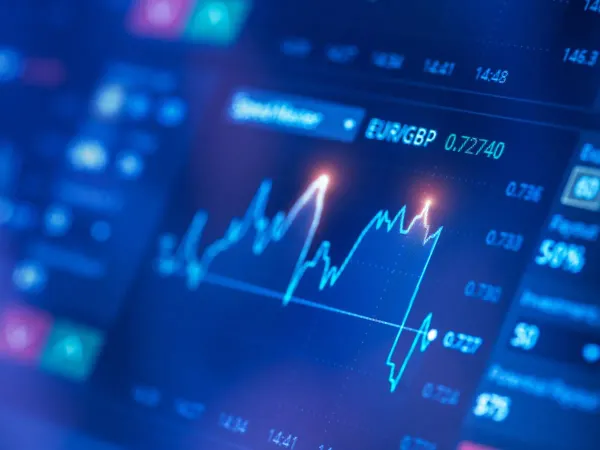
Robot's head surrounded by various social media icons, representing digital communication, learning and connectivity.
Has Machine Learning Become the New Trading Standard for Delivering Accuracy on Wall Street?
The ongoing artificial intelligence boom will have a significant on the future of stocks and CFD trading as well as countless more investment strategies. The predictive power of machine learning will be a particularly strong component in the technological trader’s arsenal.
Machine learning (ML) is a field of AI that’s capable of processing significant amounts of data to learn from and use as a foundation for decision-making. This means of learning requires no human supervision and can be virtually limitless in terms of the volume algorithms can use to learn from.
With the global ML market expected to reach a valuation of $209.91 billion by 2029 at an astonishing compound annual growth rate (CAGR) of 38.8%, the technology’s use cases within the stocks trading landscape are only set to increase.
Given the significant level of fundamental analysis used to shape trading strategies throughout markets, the ML revolution could be a lucrative one for many traders. But what can the technology deliver when it comes to financial markets? Let’s take a deeper look at a transformative technology that could disrupt Wall Street as we know it:
The Era of Predictive Analytics
With the ability to tap into historical data to look at future trends, machine learning can conduct high-quality fundamental analysis built around extensive analysis of past performance for various stocks, commodities, and other financial instruments.
Crucially, predictive analytics can look beyond price patterns and trading volume to take into account far more factors to shape estimates over future trends.
We’re also seeing use cases surrounding predictive analytics trading emerge at a rapid pace. In March 2024, a study was published in Humanities and Social Sciences Communications whereby a team of researchers used the Long Short Term Memory (LSTM) machine learning algorithm to analyze primary and secondary data surrounding the Vietnamese stock market.
The result of the study saw the ML algorithm operate at an accuracy rate of 93%, representing an impressive level of efficiency for the emerging technology.
The depth of information used in ML algorithms can seem limitless to human minds, and this faction of AI can utilize satellite imagery of crop performance or container ports to gain valuable insights to shape forecasts.
Quantifying Sentiment
While primary market data can be a difficult challenge for human traders to monitor and use to shape accurate decisions, many market movements come as a result of changes in sentiment.
Sentiment analysis transcends metrics like volume and signals and instead takes into account the discussions being shared on social media, newspaper opinion, online forums, and other spaces where key traders can gain insights into how investors actually feel about stocks and commodities.
Without AI and ML, sentiment analysis would be a bridge too far for most traders, but machine learning algorithms can actively conduct social listening to scout for mentions of specific stocks and use natural language processing (NLP) to interpret the wider context surrounding these conversations to understand the level of favorability surrounding the assets.
Empowering High-Frequency Trading
Machine learning can also be used in high-frequency trading (HFT) to accurately anticipate stock price movements before executing them as soon as an opportunity emerges.
The beauty of ML and HFT is that traders gain the ability to capitalize on minuscule price discrepancies to maximize profitability more accurately.
Because traders have to operate within congested markets, the insights unearthed by ML may only appear for an instant, meaning that coupling algorithms with fast-acting automation technology offer a frictionless way to trade.
To create a more sustainable ML and HFT outlook, it’s worth investors to use their tools alongside leading stocks and top CFD brokers that offer high-frequency trading as one of their core features.
Is ML Trading Flawless?
Although the quality of technical and sentiment-based insights unearthed through machine learning algorithms can provide far more depth in shaping trading strategies, is it really a flawless way for traders to make money?
At this point, it’s worth looking at the random walk theory, which illustrates the uncertainty of the stock market as a key characteristic.
Markets are dynamic, and although many factors that shape price movements can be anticipated, other factors can emerge out of the blue and blindside traders at a moment’s notice.
Natural disasters, unexpected news items, and many other unforeseen circumstances are all factors that are extremely difficult for even the most advanced ML algorithms to identify and factor into calculations.
Additionally, machine learning can only be as smart as the information it learns, and this could mean the technology picks up the irrationality of other traders.
Forming a Symbiotic Relationship
It’s the frailties of ML that make it imperative for traders to form a relationship with the technology they use.
Artificial intelligence and machine learning will transform investing, but traders need to continue to monitor their algorithms as they grow.
This new era of technological innovation will have a significant influence on the future of stocks and CFD trading, but only with humans on hand to learn alongside their algorithms.


